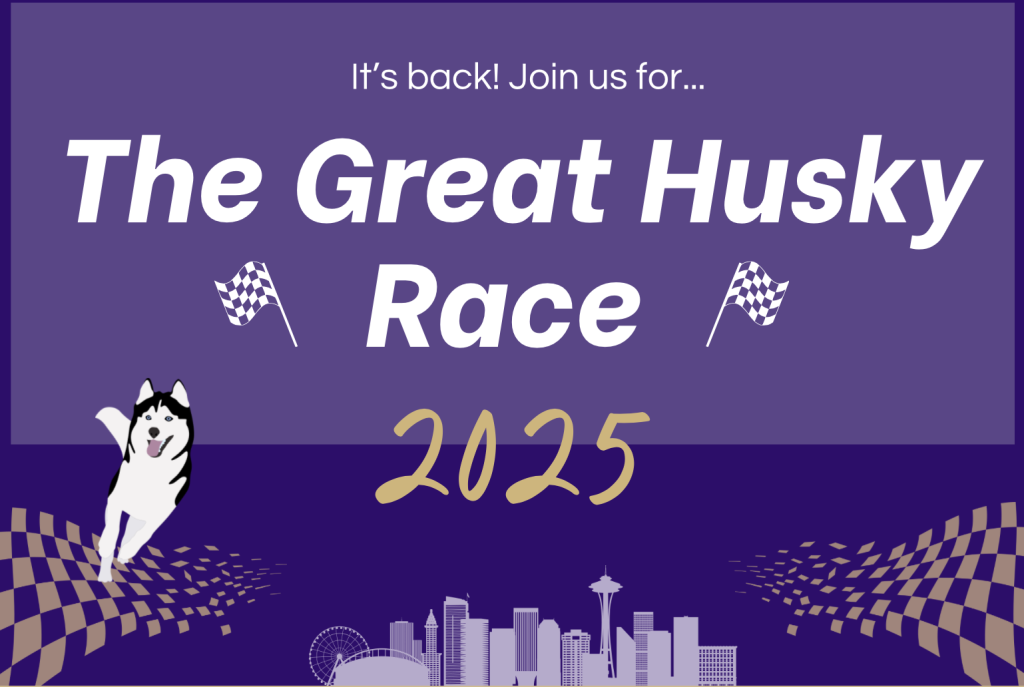The Great Husky Race

Team movement challenge
EmBARK on a movement challenge this spring with your fellow Huskies!
The Third Annual Great Husky Race (est. 2021) is upon us! This year we make an expedition through the Pacific Northwest (race route below). Individuals or teams of up to four can combine their daily miles to “travel” from Spokane to La Push. During this race, foster a sense of community at the UW with your team and other participating Huskies and learn some tips and tricks for nurturing your health and well-being.
LiveWell is happy to collaborate with the Residential Community Student Association (RCSA) to offer The Great Husky Race this year. RCSA offers a whole month of wellness activities and events from April 21-May 17, open to Housing & Food Services residents.
What is The Great Husky Race?
- The Great Husky Race is a team movement challenge from April 21 to May 15.
- You can walk, jog, run, wheelchair, or skip to get your movement tracked by the device of your choice (watch, phone app, etc.).
- Each week, you will submit how many miles you walked, ran, or wheel-chaired. Then our Peer Health Educator team will add up the miles your Great Husky Race team traveled, so that weekly totals and progress of your team can be announced.
- Celebrate all your hard work with us at the Award Ceremony on May 17 (time TBA) after the Purple & Gold Rush 5K led by RCSA.
Questions? Please contact lwpeer@uw.edu.
What is the route?
To finish the whole route (558 miles) by the end of the race, each member of a team of four will have to move at least 5 miles/day. For a team of three, each member will have to move at least 6.5 miles/day.
Marker 1: Leavenworth: 193 miles
Marker 2: Seattle: 327 miles
Marker 3: Tacoma: 361 miles
Marker 4: Olympia: 391 miles
Marker 5: Forks: 543 miles
Marker 6: La Push: 558 miles
Bonus Challenge: Finish in Seattle! +231 miles after La Push = 764 miles total
How do I participate?
If you are interested in participating but do not have a team:
We will assign you to a team with other people who also register individually.
If you are interested in registering as a team (of up to four members):
Please have one team member fill out the form and mention each other’s names.
Fill out the registration form here (UW net-id access only)!
You must be an enrolled UW student, faculty, or staff member to participate in The Great Husky Race.
Every week:
- Our Peer Health Educators will send you a link to submit your weekly miles.
- We will release an email update of where teams are in their progress of the route.
If you’re looking for places near campus to get your miles in, check out The Great Husky Race Mileage “Cheat Sheet”
How do I track my miles?
There are a variety of apps you can use to track your movement. For starters, the Health app on iPhones automatically logs all your movement throughout the day, so for a low-stress way of tracking your mileage, this is your best bet.
Instructions of how to set up iPhone mileage tracking:
- Open the health app and go to the summary page.
- Click “edit” in the top right hand corner.
- Click the star next to “Walking + Running Distance”, under the activity category.
- That’s it! Keep track of your daily/weekly miles and let your designated Peer Health Educator know your weekly total at the end of the week!
Alternatively, you could install an app to record your physical activity manually, including:
- Strava
- Nike Run Club
- MapMyRun
- Zombies, Run
Why is movement important for our health?
Time and time again it has been proven that one of the best things to do for your mental and physical health is to move your body:
- approximately 31% of the world’s adult population do not meet the global recommendation of at least 150 minutes of moderate-intensity physical activity per week
- the leading cause of death in the United States is heart disease and is directly correlated with increased rates of physical inactivity, high blood pressure, high cholesterol, diabetes, and obesity
- 80% of premature deaths from heart disease are preventable from having regular physical activity, a healthy diet, and reduced tobacco use
- movement and belonging have been shown to be two of the most effective ways to manage anxiety, depression, stress, and loneliness
By moving our bodies and engaging with others in our pack, we can take care of our bodies and minds. Let’s put on our hiking boots, crocs, or slippers, tie our shoes, and get ready to race!
Our inspiration for The Great Husky Race
“In January 1925 an outbreak of diphtheria threatened to wipeout the town of Nome, Alaska, sparking fears that an epidemic would spread and kill thousands if antitoxin medicine was not supplied. The antitoxin could only be delivered by dogsled across a portion of the Iditarod Trail, the only route accessible for transporting goods during the harsh winters. A heroic relay of Husky dog teams transported the antitoxin across the 674 mile trail from Nenana to Nome braving gale force winds, -85 degree temperatures, and whiteout conditions across the remote Alaskan Interior. The life-saving serum was delivered to Nome in a record-breaking 127.5 hours, without a single broken vial. This came to be known as the 1925 Serum Run. Many aspects of this journey are commemorated annually in the Iditarod dog sled race.”
It is in the spirit of the 1925 Serum Run that Peer Health Educators first built The Great Husky Race and offered it as a movement challenge during the COVID-19 pandemic. Learn more about the history of the 1925 Serum Run (The Great Race of Mercy) run by Togo and Balto.
